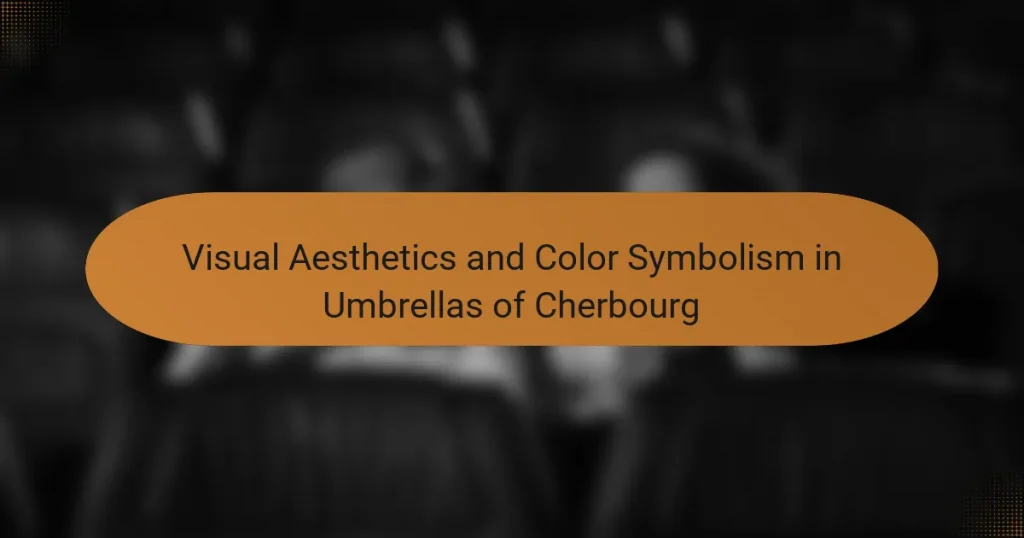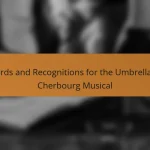The article explores the visual aesthetics and color symbolism in the film “Umbrellas of Cherbourg.” It highlights how vibrant colors and bold design choices enhance emotional expression and narrative themes, with specific colors representing various feelings—yellow for happiness and blue for sadness. The meticulous set and costume design, along with cinematographer Jean Rabier’s lighting techniques, contribute to the film’s unique visual impact. Additionally, the article examines the cultural implications of these aesthetic choices, emphasizing their role in reflecting societal themes and fostering audience engagement within the context of 1960s France. Overall, the integration of color and music enriches the storytelling, making “Umbrellas of Cherbourg” a significant cultural artifact.
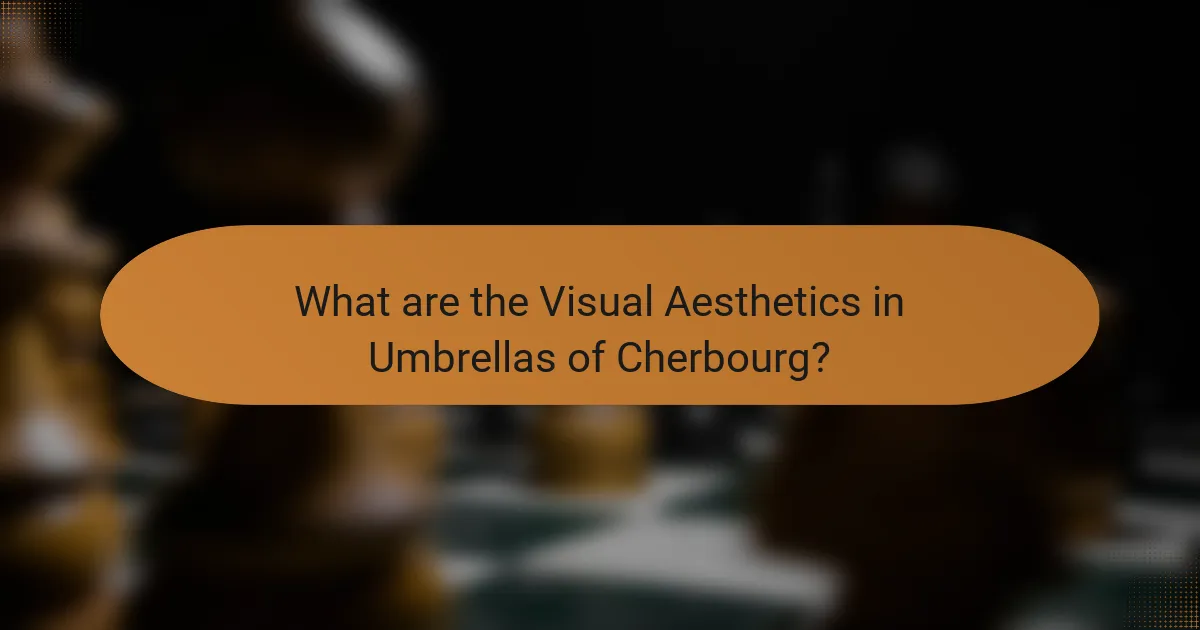
What are the Visual Aesthetics in Umbrellas of Cherbourg?
The visual aesthetics in “Umbrellas of Cherbourg” are characterized by vibrant colors and bold design choices. The film employs a color palette dominated by primary colors, which enhances emotional expression. Each color serves a symbolic purpose, reflecting characters’ feelings and narrative themes. For instance, yellow signifies happiness, while blue represents sadness. The use of meticulously crafted sets and costumes adds to the film’s overall visual impact. Cinematographer Jean Rabier’s lighting techniques further emphasize the emotional tone of scenes. The combination of these elements creates a unique visual experience that complements the musical format.
How do visual elements contribute to the film’s narrative?
Visual elements significantly contribute to the film’s narrative by enhancing emotional depth and storytelling. In “Umbrellas of Cherbourg,” color is utilized to symbolize characters’ emotions and relationships. For example, the vibrant use of yellow reflects joy and optimism, while red signifies passion and love. The film’s unique visual style, characterized by its use of color and composition, guides the audience’s emotional response. Each scene is meticulously crafted to align with the narrative’s progression. The integration of visual elements creates a cohesive storytelling experience, allowing viewers to connect with the characters on a deeper level. This approach emphasizes the film’s themes of love, loss, and longing. The visual aesthetics serve not only as a backdrop but as a vital component of the narrative itself.
What specific visual techniques are employed in the film?
The film employs several specific visual techniques. These techniques include the use of vibrant color palettes. Each color symbolizes emotions and themes throughout the narrative. The cinematography features long takes that enhance the emotional depth. The framing often focuses on close-ups, capturing character expressions. Additionally, the film utilizes innovative set designs that reflect the mood. The integration of music and visuals creates a seamless experience. These techniques collectively contribute to the film’s unique aesthetic.
How do color palettes enhance the storytelling?
Color palettes enhance storytelling by conveying emotions and setting the tone. They create visual connections to the narrative. In “Umbrellas of Cherbourg,” vibrant colors reflect characters’ feelings. For instance, warm hues symbolize love and passion. Conversely, cooler tones indicate sadness or loss. Color transitions align with the plot’s emotional shifts. This visual strategy deepens audience engagement. Research indicates that color influences perception and memory, reinforcing the story’s impact. Thus, effective color palettes are essential for immersive storytelling.
Why is color symbolism significant in Umbrellas of Cherbourg?
Color symbolism is significant in Umbrellas of Cherbourg because it conveys emotional depth and narrative progression. Each color represents specific themes and character emotions. For example, the use of vibrant colors reflects youthful hope and love. In contrast, darker shades signify loss and melancholy. The film’s visual palette enhances the storytelling by aligning color with character arcs. This intentional use of color creates a strong emotional resonance with the audience. Through color, the film communicates complex feelings without dialogue. The symbolism of color thus serves as a crucial storytelling device in the narrative.
What emotions do different colors evoke in the film?
Different colors evoke specific emotions in the film “Umbrellas of Cherbourg.” For example, the color red symbolizes passion and love. This is evident in scenes featuring the red umbrellas and the vibrant costumes. Yellow conveys happiness and optimism, enhancing the joyful moments in the film. Blue represents sadness and longing, often associated with the character’s emotional struggles. Green signifies hope and renewal, reflecting moments of potential change. The strategic use of these colors intensifies the emotional narrative throughout the film. Each color choice aligns with the characters’ experiences, reinforcing the overall thematic elements.
How does color symbolism reflect character development?
Color symbolism reflects character development by visually representing emotional states and transformations. In “Umbrellas of Cherbourg,” colors are strategically used to convey characters’ feelings. For example, vibrant colors like yellow signify joy and hope, aligning with characters’ optimistic moments. Conversely, darker shades such as blue indicate sadness or despair, mirroring the characters’ struggles. This visual language enhances the narrative by allowing viewers to intuitively grasp character arcs. Studies have shown that color can evoke specific emotional responses, reinforcing the connection between color choices and character evolution. Thus, color symbolism serves as a powerful tool in illustrating the depth of character development throughout the film.
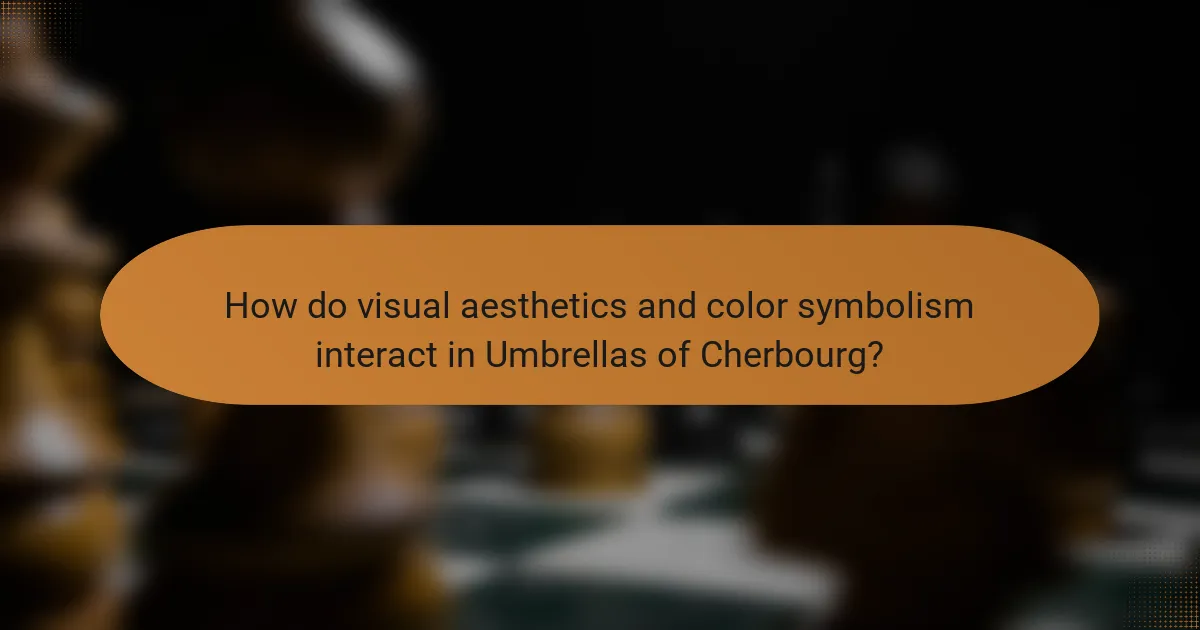
How do visual aesthetics and color symbolism interact in Umbrellas of Cherbourg?
Visual aesthetics and color symbolism in “Umbrellas of Cherbourg” interact to convey emotional depth and narrative themes. The film uses vibrant colors to represent characters’ moods and relationships. For instance, the recurring use of yellow symbolizes hope and joy, while blue often reflects sadness and longing. The aesthetic choices enhance the storytelling, making emotions palpable. Additionally, the visual style mirrors the operatic nature of the film, where dialogue is sung. This integration of color and aesthetics creates a cohesive experience. The film’s director, Jacques Demy, intentionally crafted this relationship to deepen audience engagement.
What are the key themes represented through color and visuals?
Key themes represented through color and visuals in “Umbrellas of Cherbourg” include love, nostalgia, and loss. The use of vibrant colors symbolizes the intensity of emotions. For instance, red often represents passion and desire. Soft pastels evoke a sense of innocence and nostalgia. The contrasting colors highlight the tension between joy and sorrow. Visual elements, such as lighting and composition, further enhance these themes. The film’s aesthetic choices create a dreamlike quality, reinforcing emotional depth. Overall, color and visuals play a crucial role in conveying the narrative’s emotional landscape.
How does the use of color correlate with the film’s themes?
The use of color in “Umbrellas of Cherbourg” directly correlates with the film’s themes of love, loss, and longing. The vibrant color palette reflects the emotional intensity of the characters’ experiences. For example, the predominant use of yellow symbolizes hope and happiness, particularly in scenes of romantic bliss. Conversely, the use of blue conveys sadness and melancholy, particularly during moments of separation. The contrasting colors create a visual representation of the characters’ emotional journeys. Specific scenes illustrate this correlation, such as the bright colors in the beginning contrasting with the muted tones in the later parts of the film. This shift visually reinforces the transition from joy to despair. Overall, the color choices enhance the narrative by deepening the audience’s emotional connection to the characters and their struggles.
What visual motifs are repeated throughout the film?
The visual motifs repeated throughout “Umbrellas of Cherbourg” include umbrellas, colors, and patterns. Umbrellas symbolize both protection and emotional barriers. The film prominently features vibrant colors that reflect the characters’ emotions and experiences. Each color choice, such as yellow for joy and blue for sadness, reinforces the narrative. Patterns in clothing and backgrounds create a rhythmic visual experience. These motifs contribute to the film’s overall aesthetic and emotional depth. The repetition of these elements enhances the storytelling and connects the audience to the characters’ journeys.
How do specific scenes exemplify visual aesthetics and color symbolism?
Specific scenes in “Umbrellas of Cherbourg” exemplify visual aesthetics and color symbolism through their vibrant color palettes and composition. The film employs a distinct use of color to convey emotions and themes. For instance, the frequent use of yellow represents warmth and hope, particularly in scenes featuring Geneviève and her mother. In contrast, blue hues often symbolize sadness and longing, especially during moments of separation. The striking visuals are enhanced by the film’s unique aesthetic, characterized by its operatic style and integration of music with imagery. Each scene is meticulously crafted to reflect the emotional state of the characters, reinforcing the narrative. This intentional use of color and visual style creates a rich tapestry of meaning, allowing viewers to engage with the characters’ emotional journeys on a deeper level.
Which scenes are pivotal in showcasing these elements?
The pivotal scenes that showcase visual aesthetics and color symbolism in “Umbrellas of Cherbourg” include the opening sequence, the vibrant market scene, and the final reunion. The opening sequence features bold colors and dynamic movement, establishing the film’s visual style. The market scene highlights the use of color to convey emotions and themes, with umbrellas symbolizing hope and love. The final reunion scene utilizes color shifts to represent the characters’ emotional journeys. These scenes collectively illustrate the film’s unique approach to color and visual storytelling.
What techniques are used in these scenes to enhance visual impact?
Techniques used in these scenes to enhance visual impact include vibrant color palettes and dynamic camera movements. The film employs a rich spectrum of colors to evoke emotions and symbolize themes. For instance, bright reds and yellows convey passion and joy, while blues and greens suggest melancholy. Additionally, the use of close-ups captures characters’ emotions effectively. Fluid transitions between scenes create a seamless visual experience. The integration of music with visual elements amplifies emotional resonance. These techniques collectively elevate the overall aesthetic and narrative depth of the film.
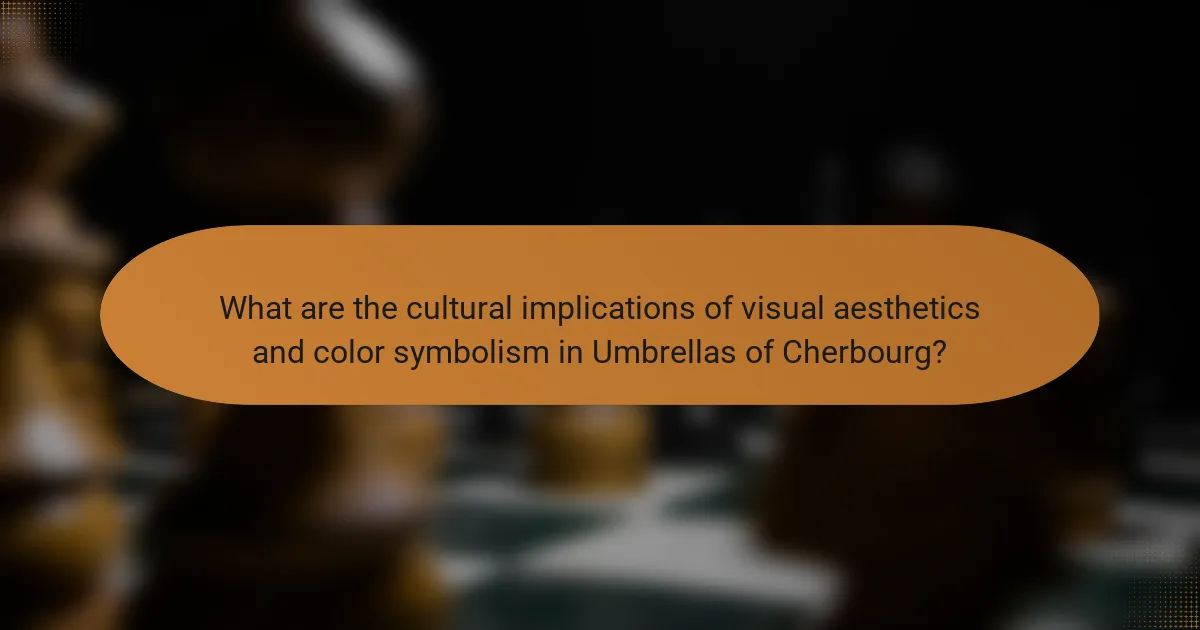
What are the cultural implications of visual aesthetics and color symbolism in Umbrellas of Cherbourg?
The cultural implications of visual aesthetics and color symbolism in “Umbrellas of Cherbourg” highlight emotional narratives and societal themes. The film employs vibrant colors to convey mood and character emotions. For example, the use of yellow symbolizes happiness and optimism, while blue often represents sadness and longing. These color choices reflect the characters’ inner struggles and societal expectations. The film’s aesthetic draws from French New Wave cinema, emphasizing realism and emotional authenticity. This approach fosters a deeper connection between the audience and the characters. Additionally, the visual style influences perceptions of love, loss, and hope within the cultural context of 1960s France. The integration of music and color further enriches the storytelling, making it a significant cultural artifact.
How does the film reflect the cultural context of its time?
The film “Umbrellas of Cherbourg” reflects the cultural context of its time through its innovative use of color and musical storytelling. Released in 1964, it coincided with the French New Wave movement. This movement emphasized artistic experimentation and personal expression. The film’s vibrant colors symbolize emotions and societal changes of the 1960s. For instance, the use of bold primary colors represents optimism and the youthful spirit of post-war France. Additionally, the film addresses themes of love, war, and social class, reflecting the anxieties and aspirations of the era. The integration of music as dialogue showcases a shift in cinematic storytelling, aligning with contemporary cultural trends. Overall, “Umbrellas of Cherbourg” serves as a visual and auditory representation of 1960s French society.
What societal issues are highlighted through visual and color choices?
Visual and color choices in “Umbrellas of Cherbourg” highlight societal issues such as class disparity and emotional turmoil. The vibrant colors represent hope and joy, contrasting with the underlying themes of loss and longing. For instance, the use of bright yellow signifies optimism, while darker shades illustrate despair. The film’s palette reflects the characters’ emotional states and societal constraints. Research shows that color can influence perception and evoke specific emotions, emphasizing these societal issues. The juxtaposition of colors serves to critique social realities, showcasing the impact of economic conditions on personal relationships.
How do aesthetics and symbolism resonate with contemporary audiences?
Aesthetics and symbolism resonate with contemporary audiences through their emotional and cultural significance. The film “Umbrellas of Cherbourg” employs vibrant colors and visual styles to evoke specific feelings. For instance, the use of bright yellow symbolizes joy and optimism, while deeper blues convey sadness. These color choices create a visual language that audiences can interpret and connect with. Additionally, the film’s aesthetic reflects the 1960s French culture, making it relatable to modern viewers who appreciate nostalgia. Research indicates that color psychology influences viewer emotions, supporting the film’s impact. Overall, aesthetics and symbolism in “Umbrellas of Cherbourg” engage audiences by blending visual appeal with meaningful themes.
What lessons can filmmakers learn from Umbrellas of Cherbourg’s approach to visuals and color?
Filmmakers can learn the importance of color as a narrative tool from “Umbrellas of Cherbourg.” The film uses a vibrant color palette to convey emotions and themes. Each color represents specific feelings, enhancing the storytelling. For instance, the use of bold reds signifies passion, while softer pastels evoke nostalgia. This approach allows visuals to complement the narrative without dialogue. The film’s cinematography highlights how color can establish mood and tone effectively. In addition, filmmakers can observe the seamless integration of visuals and music, creating a cohesive artistic experience. This method demonstrates the potential of visuals to deepen audience engagement.
How can aspiring filmmakers apply these techniques in their work?
Aspiring filmmakers can apply visual aesthetics and color symbolism techniques by incorporating vibrant color palettes to convey emotions. They should study the use of color to represent themes and character arcs, as seen in “Umbrellas of Cherbourg.” Filmmakers can implement contrasting colors to highlight conflict or harmony within scenes. They should also consider the emotional impact of specific colors, such as red for passion or blue for sadness. Additionally, filmmakers can utilize lighting to enhance the mood and visual storytelling. Analyzing how Jacques Demy employed color and aesthetics can provide valuable insights. By experimenting with these techniques, filmmakers can create visually compelling narratives that resonate with audiences.
What best practices can be derived from the film’s visual style?
Best practices derived from the film’s visual style include the effective use of color to convey emotion. The film employs a vibrant color palette to reflect the characters’ feelings and the overall mood. For instance, warm colors signify love and happiness, while cooler tones indicate sadness and loss. Consistent thematic color usage enhances narrative coherence. Additionally, the integration of color with music creates a unique sensory experience. The film’s visual storytelling demonstrates that visuals can complement and elevate the narrative. By analyzing these techniques, filmmakers can learn to use color intentionally to evoke specific emotions and enhance storytelling.
The main entity of the article is “Visual Aesthetics and Color Symbolism in Umbrellas of Cherbourg.” The article examines how vibrant colors and bold design choices in the film enhance emotional expression and narrative themes. It details the significance of color symbolism, illustrating how specific hues reflect characters’ emotions and development. Additionally, it analyzes visual techniques such as cinematography and set design that contribute to the film’s unique aesthetic and storytelling, while also addressing cultural implications and lessons for contemporary filmmakers.
